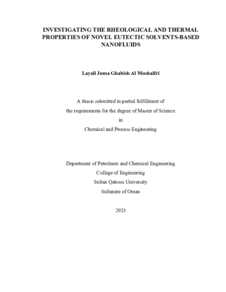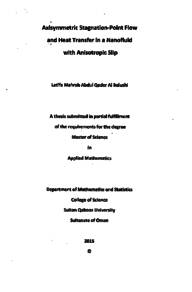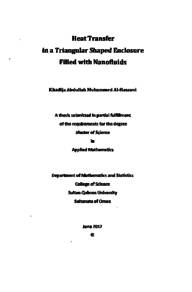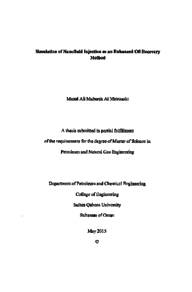Document
Heat transfer in Fe3O4-H2O nanofluid contained in a triangular cavity under a sloping magnetic field.
Identifier
https://doi.org/10.24200/squjs.vol23iss1pp56-67
Source
Sultan Qaboos University Journal for Science. v. 23, no. 1, p. 56-67.
Other titles
انتقال الحرارة في حاوية مثلثة تحوي المائع النانوي لأكسيد الحديد - ماء تحت تأثير مجال مغناطيسي منزلق.
Country
Oman.
City
Muscat.
Publisher
College of Science, Sultan Qaboos University.
Gregorian
2018-05-06
Language
English
Subject
English abstract
Numerical simulation is performed to explore the convective heat transfer characteristics of Fe3O4-H2O nanofluid contained in a right-angle triangular cavity considering three types of thermal boundary conditions at the bottom wall. No heat is allowed to escape through the insulated vertical wall, whereas the inclined wall is kept colder than the bottom one. A sloping magnetic field whose strength is unvarying acts upon the cavity. The physical model is converted to the mathematical form through coupled highly nonlinear partial differential equations. These equations are then transformed into the non-dimensional form with the help of a group of transformations of variables. A very robust pde solver COMSOL Multiphysics that uses the finite element method (FEM) of Galerkin type is applied to carry out the numerical calculation. Heat transfer escalation through middling Nusselt number at the lowermost cavity wall is explored for diverse model parameters and thermal circumstances. The outcomes lead us to conclude that a higher degree of heat transfer is accomplished by reducing the dimension of nanoparticles and aggregating the buoyancy force through the Rayleigh number. It is highest when there is a magnetic field leaning angle of 900 and the lowermost wall is heated homogenously.
ISSN
2414-536 X
Arabic abstract
تم إجراء محاكاة عددية لاستكشاف خصائص نقل الحرارة بالحمل الحراري للمائع النانوي Fe3O4-H2O الموجود في تجويف مثلث قائم الزاوية مع الأخذ في الاعتبار ثلاثة أنواع من ظروف الحدود الحرارية في الجدار السفلي. لا يسمح للحرارة بالهروب من خلال الجدار العمودي المعزول، في حين يبقى الجدار المائل أكثر برودة من الجدار السفلي. يؤثر المجال المغناطيسي المائل الذي لا تتغير قوته على التجويف. يتم تحويل النموذج المادي إلى النموذج الرياضي من خلال معادلات تفاضلية جزئية غير خطية إلى حد كبير. ثم يتم تحويل هذه المعادلات إلى الصورة غير الأبعاد بمساعدة مجموعة من تحويلات المتغيرات. يتم تطبيق برنامج COMSOL Multiphysics القوي جدًا لتحليل pde والذي يستخدم طريقة العناصر المحدودة (FEM) من نوع Galerkin لإجراء الحساب العددي. تم استكشاف تصاعد انتقال الحرارة من خلال رقم نسلت المتوسط في جدار التجويف السفلي لمعلمات نموذجية متنوعة وظروف حرارية. تقودنا النتائج إلى استنتاج أن درجة أعلى من انتقال الحرارة يتم تحقيقها عن طريق تقليل أبعاد الجسيمات النانوية وتجميع قوة الطفو من خلال رقم رايلي. ويكون أعلى عندما تكون زاوية ميل المجال المغناطيسي 900 ويتم تسخين الجدار السفلي بشكل متجانس.
Category
Journal articles





